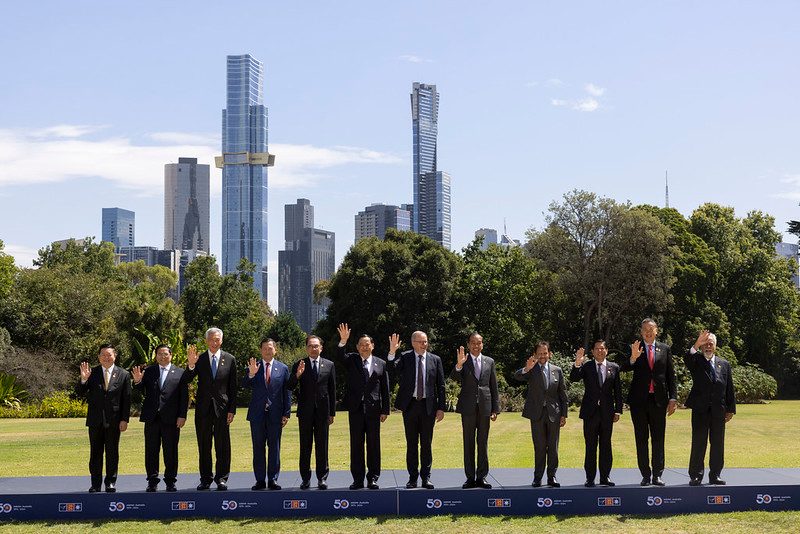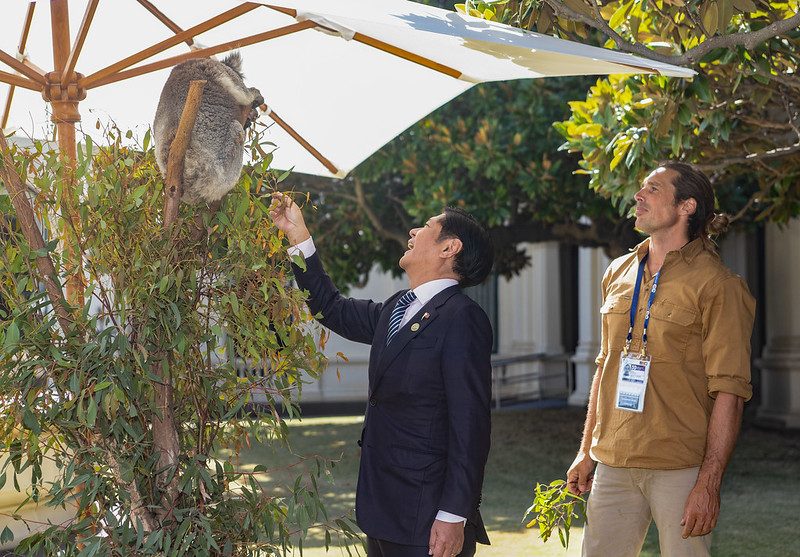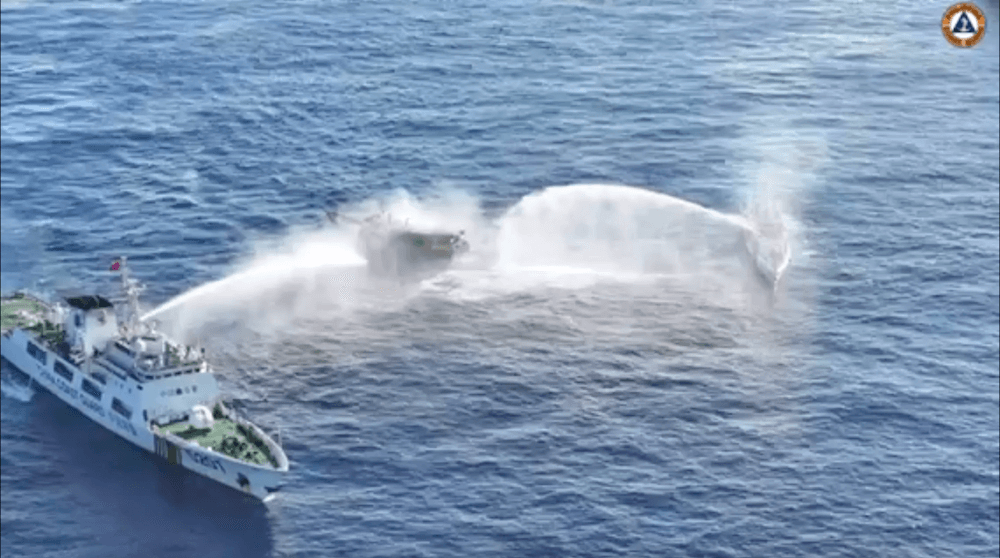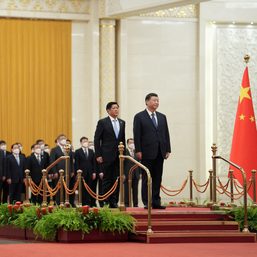SUMMARY
This is AI generated summarization, which may have errors. For context, always refer to the full article.

There is one thing that the Association of Southeast Asian Nations (ASEAN) can agree on at any given time: the importance of ASEAN centrality, or the notion that the bloc must be the “dominant regional platform to overcome common challenges and engage with external powers.”
And there’s another thing the 10 members can agree on: that a “peaceful, friendly and harmonious environment” must be promoted in the South China Sea.
But it’s on the details – such as how those aspirations can be met – that members sometimes disagree on.
That ASEAN members differ, for instance, over how they deal with superpower China, is no secret.
But those differences were thrust in the spotlight in the first week of March, as Melbourne hosted ASEAN leaders in a special summit to commemorate 50 years of Australia as the bloc’s first external partner.
Philippine President Ferdinand Marcos Jr., speaking at a Lowy Institute event ahead of the summit proper, promised to “push back” against Beijing should it question or ignore “our sovereignty, sovereign rights, and our jurisdiction in the West Philippine Sea” even as he promised to “cooperate with [China] on matters where our interests align.”
“We, in the Indo-Pacific, must ensure that great powers do not treat the world as an arena for their competition. The pursuit of the great powers’ respective strategic goals must never come at the expense of the interests of smaller states, nor of regional and international peace,” Marcos said in his speech.
His rhetoric in Melbourne was a continuation of an assertion he made days earlier in Canberra, when he addressed Australia’s parliament. If not for an awkward, prolonged, and nerve-wracking coughing fit, the Melbourne speech would have been among his best as Manila’s top diplomat yet – but I digress.

Ahead of the summit, too, Australia’s Foreign Minister Penny Wong warned against “claims and actions that are inconsistent with international law” and “destabilizing, provocative and coercive actions, including unsafe conduct at sea and in the air and militarization of disputed features” that “give rise to the most confronting circumstances in our region in decades.”
Wong opened the Maritime Cooperation Forum of the summit alongside her Filipino counterpart, Secretary Enrique Manalo, who was keynote speaker.
The Australian minister didn’t name who was making those actions, although later on “[welcomed] the resumption of leader-level and military-level dialogue between the United States and China.”
But as Marcos was trying to rally the Indo-Pacific behind the “rules-based order” and amping up rhetoric against China on the West Philippine Sea, his fellow ASEAN leaders expressed considerably less concern over China’s activities in the region.
“My reference to China-phobia is because the criticism levied against us for giving additional focus to China. My response is, trade and investments is open and right now, China seems to be the leading investor and trade into Malaysia,” said Malaysian Prime Minister Anwar Ibrahim in a joint press conference with Australian Prime Minister Anthony Albanese.
Anwar earlier expressed concern over “Sinophobia” in the West.
“If they have problems with China, they should not impose it upon us. We do not have a problem with China,” the Malaysian leader added.
Singapore’s Prime Minister Lee Hsien Loong, meanwhile, explained the complicated situation, in a separate press conference with Albanese.
“ASEAN countries have a common position on the South China Sea but we also have different national perspectives, and going beyond the ASEAN common position, different national positions. That national positions are different is because our situations are different. Some ASEAN countries do not even have a littoral on the South China Sea, they do not face the South China Sea,” he said.
“Singapore takes no position on the claims but we have a strong view on international law and on freedom of navigation, which we have stated many times,” he added.
A Code of Conduct on the South China Sea has been a long-time aspiration for the bloc and China. Negotiations started in 2018 or 6 years ago, with no conclusion expected soon.
So, what’s next for the Philippines and its new-found crusade to assert its rights in the West Philippine Sea?
We await Marcos’ speeches in Germany and the Czech Republic – but perhaps more specifically, the speech he’s set to deliver at the Shangri-La Dialogues in Singapore.
After all, while Marcos was making a case for supporting the Philippines in the West Philippine Sea, Filipino soldiers and Coast Guard personnel were dodging Chinese harassment in Ayungin Shoal.
The Unaizah May 4, a civilian vessel on a test run to Ayungin Shoal, was hit by two China Coast Guard water cannons, shattering its wind shield and injuring four Navy personnel last March 5.

ASEAN shakes it off?
Speaking of Singapore – Prime Minister Lee faced a rather interesting question during the same press conference in Melbourne: Did Singapore really pay Taylor Swift to make sure she’d only have one stop in the region?
And, more importantly, asked the Sydney Morning Herald: “Are you encountering any bad blood here from other Southeast Asian nations?”
A rather bemused Lee confirmed the deal, admitting “certain incentives provided to her from our tourism (recovery) fund.”
“I do not see that as being unfriendly. Sometimes one country makes a deal, sometimes another country does. I do not explicitly say you will come here, only on condition that you will go other places,” he said.
He added: “If that is what needed to be done to get an outcome which is mutually beneficial, and which from Singapore’s point of view, serves not just to grow the economy, but also to bring in visitors and goodwill from all over the region, I do not see why not. If we had not made such an arrangement, would she have come to someplace else in Southeast Asia or more places in Southeast Asia? Maybe, maybe not. These are things that she will decide.”
Certainly, Singapore felt the American singer’s electric touch. Hers was the (not so) invisible string that made its way around the island state: Everywhere you went, there were promos related to the singer’s 6-night Singapore stop. Her music was impossible to avoid, even in establishments without Eras Tour promos.
The Washington Post reported that Swift’s stop could bring in between $260 million to $375 million in tourism receipts to Singapore.
Thailand’s Prime Minister Srettha Thavisin made the first public fuss over the deal. A Filipino legislator then asked the Philippine Department of Foreign Affairs (DFA) to file a protest over it. The DFA, of course, did not react to the call – they have more pressing concerns to address, after all.
Swift herself didn’t react to the regional controversy but thanked the March 9 crowd – the last Eras Tour show for a few months – not just for selling out her Singapore stop, but for counting days and counting miles just to reach the Singapore National Stadium.
Will you fight for your country?
And, in decidedly more local news, according to an Octa Research survey, majority of adult Filipinos (77%) said they were “ready to fight for [the] country” in the event of a conflict between the Philippines and a foreign enemy.
Willingness to serve was highest among 45-54 year-olds, and lowest among the senior and almost senior citizens (between 45-54, at 87%), the oldest of adults (75 and up, at 72%), and young adults (18-24, at 74%).
“The Armed Forces of the Philippines (AFP) appreciates the patriotism of our fellow Filipinos who pledged their willingness to fight for the country,” said AFP chief General Romeo Brawner Jr., reacting to the survey that the AFP itself commissioned.
He added: “The ways by which we can help defend our country, other than fighting, are only bounded by our imagination. Let us take the result of the survey as a call to action and prepare for when we are called upon by the government to defend the State.” – Rappler.com
Add a comment
How does this make you feel?

















![[Just Saying] SONA 2024: Some disturbing points](https://www.rappler.com/tachyon/2024/07/TL-marcos-sona-points-july-23-2024.jpg?resize=257%2C257&crop=335px%2C0px%2C720px%2C720px)

There are no comments yet. Add your comment to start the conversation.